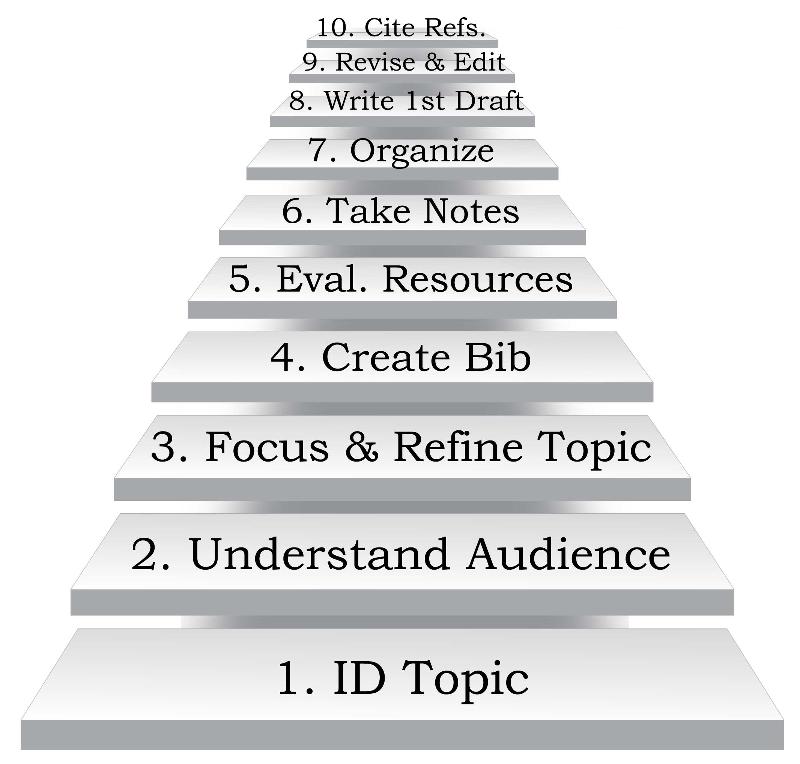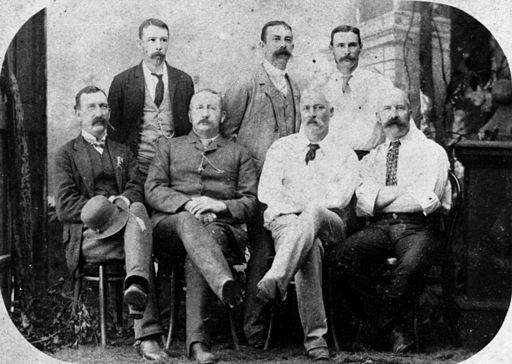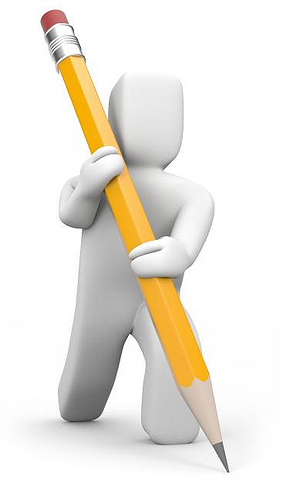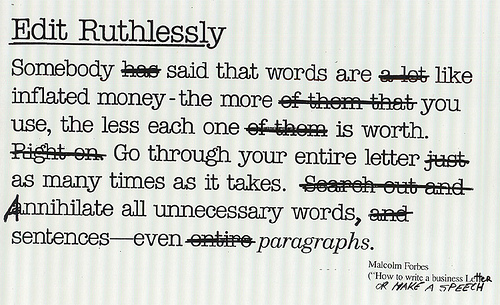
iStudy for Success!
Online learning tutorials for essential college skills.
The purpose of this tutorial is to acquaint or reacquaint you with basic knowledge about preparing written reports. Use it as a guide when you are faced with the task of writing a paper or a report.
Upon completion of this tutorial, you will be able to:
Read the information about writing reports, then complete the activities.
Note: All external links in this tutorial will open in a new window or tab.
There are several different types of papers or reports that you may be called upon to write throughout your academic career and beyond. Below is a brief description of four different types.

A descriptive report discusses or explains a topic of interest. Typically a substantial amount of research is required in order to provide a comprehensive explanation of a topic.
A literary paper analyzes the work(s) of an author. The analysis can be accomplished by comparing and contrasting different works, or by analyzing various elements within a specific work. Your analysis of the literary work(s) should also demonstrate that you have read what other authorities have written about the work.
An argumentative paper builds a logical argument for a particular position on an issue and supports that argument with research. Typically, an issue has two opposing points of view. When building your argument, you argue for your position and against the other.
A position paper states a position and supports it with research. The position paper differs from an argumentative paper because it is not necessary to argue against any opposing points of view.
Check to see if you understand different types of reports by completing the short quiz below.

The best way to write a report is to create a plan. Approaching the task systematically helps you break down a large job into smaller, more manageable tasks. The logical steps for writing a report are listed below and explained in this tutorial. 
Identifying what you want to write about is the first step in writing a report. In some situations, you might be assigned a topic or given a range of topics from which to choose. In other situations, the choice may be completely up to you.
The best way to begin searching for a topic is to conduct some initial research. One way to begin is to review your course textbook(s) for topics that are of interest to you but that might not be covered in great detail during the semester. The table of contents and subject index can help you identify components of a topic. The author index can help you identify leading thinkers in the field. Next, extend this initial topic search by conducting a more complete assessment of the different topics you have in mind with a more complete search using references available at the library or on the Internet.
As you begin your search for a topic, keep the following in mind:
Along with identifying a topic for your report, you should begin to learn more about the audience who will read your report. In some instances, your professor may be the only member of the audience. In other situations you might be asked to write for a specific audience. Use the following questions to help you understand the needs of your audience. 


After you have conducted your initial research about the topic and identified the audience for whom you are writing, you can begin to narrow your topic.
There are a number of techniques that writers use to help them focus and refine their topics. A few of them are described below.
Freewriting consists of off-the-top-of-your-head writing for either a predetermined period of time (perhaps ten to fifteen minutes) or until a predetermined amount of text (one to two pages) has been written. The purpose of freewriting is to generate ideas by letting your thoughts flow freely. Therefore, when you use the technique of freewriting you do not necessarily have to be concerned about the organization of ideas, grammar, or spelling. The ideas you generate can subsequently be shaped to help you refine your topic.
Clustering, like freewriting, involves off-the-top-of-your-head idea generation. In clustering, however, the purpose is to develop a visual representation of your ideas (similar to a concept map - see the Concept Maps tutorial). Concepts can then be connected by drawing arrows between them.
Many writers find it useful to keep a journal of ideas that come to them as they begin a research paper. This journal will help you remember ideas that naturally come to you during different times of the day or night.
Who, What, Where, When, Why, and How? Journalists use these questions to help them ensure they are getting the full story, but writers can also use them to help them explore different angles or aspects of a topic.
Similar to freewriting, a brainstorming session can help you develop ideas that are connected to your topic (see the Brainstorming tutorial). As with freewriting you can choose to brainstorm for a set period of time or a set number of ideas, or you can develop a brainstorming list over a longer period of time.
A working bibliography is an organized set of bibliographic information about resources found during your research that might be helpful as you write your report. You might choose to create an index card for each resource or you can store the information in a computer file. In essence, however, you want to record information that will help you do three things:
Generally speaking, record the following for books, periodicals, and online resources:
|
For Books |
For Periodicals |
For Online References |
|---|---|---|
|
library call number (for personal refernence) |
library call number (for personal refernence) |
bookmark the site, or use software such as EndNote or Mendeley to record it |
|
names of authors, editors |
names of authors |
names of authors, editors |
|
titles and subtitle of book |
title and subtitle of article |
title and subtitle of article |
|
editions or volume number |
title of periodical |
web address (URL) |
|
publisher's name |
volume and issue |
publisher of the web site (if known) |
|
place of publication |
date of issue |
date of publication (if listed) |
|
date of publication |
page number |
date you accessed the web page/site |
Also consider writing notes to yourself about each reference, so that the reason you identified it as relevant remains meaningful to you. If the reference is a book, consider jotting down chapter titles; if it is a periodical, jot down ideas from the abstract that precedes the article which may be useful.
Once you have identified resources, begin to evaluate whether they will be useful to you. General questions to help you ascertain this are:
After you have evaluated the various resources on your topic, begin reading the information and take notes on what you read. Eventually you will organize these notes to create the structure of your report. Historically, students have taken notes on index cards that they later use to organize the structure of their reports. More recently, however, students are using computers to take notes that they later cut and paste into the report document.
There are three basic ways to take notes when researching a topic. In each case, you will want to write down the specifics about where you found the information as well as the corresponding page numbers so that you can cite the author appropriately. Good records about references and citations help to prevent plagiarizing information.
Once you have finished taking notes on what you have read, begin to organize your ideas and create a structure for your report. Your report should have three main parts: introduction, body, and conclusion. Each section serves an important function.
There are a variety of ways that you may choose to structure your ideas within the report. A few structuring techniques are described below:
Complete the quiz below to test yourself on what you just read.

Once you have developed the basic structure of your report, you can begin writing. Your goal in writing the first draft is to get your ideas onto paper. Experts indicate that there is no set process to follow, so use the process that works for you. A few suggestions that might help you get started are provided below. 
When you write your first draft, it is not important to worry about grammar, spelling, or the most appropriate word choice. The trick is to keep writing and not get bogged down by trying to make your first draft perfect. During the editing and revision stages you will be able to make the necessary changes.
Once you have completed the first draft of your report, you must revise and edit it. While the goal in writing the first draft was to put your ideas on paper, the goal of this step is to improve the manner in which you are communicating your ideas. Verify the following as you revise and edit your paper: 
Note: A downloadable RTF file of this rubric is included on the left sidebar of this page.
|
Topic |
Beginning (Totally Unrelated) 1 |
Developing (Remotely Related) 2 |
Accomplished (Somwhat Relevant) 3 |
Exemplary (Directly Relevant) 4 |
Score |
|---|---|---|---|---|---|
|
Organization (Overall order, flow, and transitions) |
Details and examples are not organized, are hard to follow and understand. |
Information is scattered and needs further development. |
Information is logically ordered with paragraphs and transitions. |
Information is presented in effective order. Excellent structure of paragraphs and transitions enhances readability and comprehension. |
|
|
Quality of Information |
Unable to find specific details. |
Details are somewhat sketchy. |
Some details don't support the report topic. |
Supporting details are specific to topic and provide the necessary information. |
|
|
Introduction |
Introductory paragraph is not apparent. |
Introductory paragraph is vague. |
Introductory paragraph is clearly stated with a focus. |
Introductory paragraph has a sharp, distinct focus and enhances the impact of the report. |
|
|
Conclusion |
Concluding paragraph is not apparent. |
Concluding paragraph is only remotely related to the report topic. |
Concluding paragraph follows and summarizes the report discussion and draws a conclusion. |
Concluding paragraph summarizes and draws a clear, effective conclusion and enhances the impact of the report. |
|
|
Grammar & Spelling |
Numerous grammatical and/or spelling errors. |
Three to five grammatical or spelling errors. |
Fewer than 3 grammatical or spelling errors. |
No spelling or grammatical errors. |
|
|
Bibliography |
Resources not cited in paper or proper format not used. |
Some resources are cited but not all. Not formatted correctly. |
All resources are cited, but formatting isn't correct. |
All resources are cited and appear with correct formatting. |
|
|
Add Your Own |
|
|
|
|
|
|
|
|
|
|
Total |
|
During the editing process you should also ensure that you have correctly cited the references that you have used. Failure to do so can be construed as plagiarism. Plagiarism is the act of using someone else's ideas in your paper without giving the author credit for them. Plagiarism is a serious offense and may result in expulsion from the University.
All ideas that you borrow from other authors must be cited. This includes ideas that you have summarized, ideas that you have paraphrased, and direct quotations. In general, everything other than common knowledge or knowledge that is not traceable to a specific source should be cited. To learn more, please see the iStudy Academic Integrity tutorial.
There are several different guidelines for citing references. For example, MLA style is the system set forth by the Modern Language Association. APA style refers to the system devised by the American Psychological Association. CBE style is recommended by the Council of Biology Editors. A fourth style is called the Chicago style. Hard copy style manuals may be purchased for each of these documentation formats, and many online sites will assist you in using a particular style correctly. Additionally, some software, such as EndNote, allows you to store references in a generic format and then export them in most of the common styles used today.
Internet help on APA and Chicago style formats can be found in many places.
For additional information on writing, please consult the following references:
* Indicates that the original Website is no longer available.
Identifying something to write about is the first step in writing a report. The best way to begin searching for a topic is to conduct some initial research.
When identifying a topic for your report, you should concurrently begin to learn more about the audience that will be reading your report.
Almost any general topic that you identify will be too broad to write about in a comprehensive manner, so you'll need to narrow your topic. There are a number of techniques that writers use to help them focus and refine their topics.
A working bibliography is an organized set of bibliographic information about the resources that you find during your research that might be helpful as you write your report.
After you've identified resources, you can begin to evaluate if they will be useful to you.
Once you've evaluated the various resources on your topic, you can begin to read them and take notes on what you read. There are three basic ways to take notes when researching a topic.
After you've taken notes on what you've read, you can begin to organize your ideas and create a structure for your report. Your report should have three main parts to it - the introduction, body, and conclusion - each serving an important function. Within the report there a variety of ways that you can structure your ideas.
Your goal in writing the first draft is to get your ideas onto paper.
The goal during this step is to improve the manner in which you are communicating your ideas.
Failure to cite references can be construed as plagiarism. Plagiarism is the act of using someone else's ideas in your paper without giving them credit for them. Plagiarism is a serious offense, which can result in expulsion from school. There are several different guidelines for citing references:
Information about the different types of documentation styles are available at the library and on the Internet.
The following are the assignments embedded in the Written Reports tutorial:
This tutorial is related to the iStudy tutorials on concept maps, brainstorming, source evaluation and search strategies, and Academic Integrity.
The instructor may want to cover the information from the tutorial in a traditional lecture format. This information is summarized in the Key Points section listed below.
Place the learners into small (3-5 person) groups. Assign each group one of the following topics:
Note that these are the main headings in the tutorial. Each group must use the tutorial as the source of information to gather data for putting together a short presentation on their topic. Each group must present their group's topic to the other groups.
Assign each student the task of preparing and delivering a short written report. Students should not only complete the report, but also list how they conceptualized and completed each step of the report writing process (as detailed in the tutorial).
[top of page]
1. Identify a Report Topic
Identifying something to write about is the first step in writing a report. The best way to begin searching for a topic is to conduct some initial research.
2. Understand Your Audience
When identifying a topic for your report, you should concurrently begin to learn more about the audience that will be reading your report.
3. Focus and Refine Your Topic
Almost any general topic that you identify will be too broad to write about in a comprehensive manner, so you'll need to narrow your topic. There are a number of techniques that writers use to help them focus and refine their topics.
4. Create a Working Bibliography
A working bibliography is an organized set of bibliographic information about the resources that you find during your research which might be helpful as you write your report.
5. Evaluate and Synthesize Resources
After you've identified resources, you can begin to evaluate if they will be useful to you.
6. Take Notes on What You Read
Once you've evaluated the various resources on your topic, you can begin to read them and take notes on what you read. There are three basic ways to take notes when researching a topic.
7. Organize Your Ideas and Create Structure
After you've taken notes on what you've read, you can begin to organize your ideas and create a structure for your report. Your report should have three main parts to it - the introduction, body, and conclusion - each serving an important function. Within the report there a variety of ways that you can structure your ideas.
8. Write the First Draft
Your goal in writing the first draft is to get your ideas onto paper.
9. Revise and Edit the Report
The goal during this step is to improve the manner in which you are communicating your ideas.
10. Cite References
Failure to cite references can be construed as plagiarism. Plagiarism is the act of using someone else's ideas in your paper without giving them credit for them. Plagiarism is a serious offense, which can result in expulsion. There are several different guidelines for citing references:
Information about the different types of documentation styles are available at the library and on the Internet.
[top of page]
Through observing the group and/or individual activity, the instructor may assess student performance. Assessment criteria are as follows (Instructors supply the percentage weights):
|
Where |
Domain |
Activities |
% |
|---|---|---|---|
|
iStudy Tutorial |
Knowledge |
By listing and giving examples, the learner can identify:
|
|
|
Assignment |
Application |
By showing written examples, the learner demonstrates knowledge of:
|
|
|
|
|
|
100% |